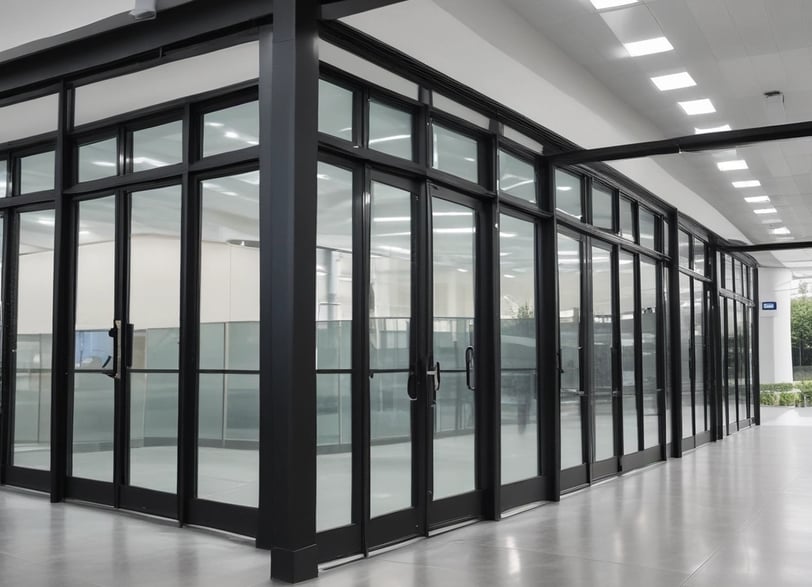The Energy Efficiency Benefits of Aluminum Doors and Windows: Why They Are Essential for Commercial Buildings
6/6/20254 min read


Understanding Energy Efficiency in Commercial Buildings
Energy efficiency refers to the ability to utilize less energy to provide the same level of service or output. In the context of commercial buildings, achieving energy efficiency is essential not only for reducing operational costs but also for meeting environmental standards and sustainability goals. As energy consumption continues to rise globally, commercial establishments face increasing pressure to meet regulatory demands and demonstrate their commitment to minimizing their carbon footprint.
The significance of energy efficiency in commercial buildings cannot be overstated. Effective energy management leads to reduced utility bills, which is particularly vital for businesses where operational costs can significantly impact the bottom line. Furthermore, energy-efficient buildings contribute positively to the environment by decreasing greenhouse gas emissions and reducing the overall demand on energy resources, which is increasingly critical in the face of climate change.
However, achieving energy efficiency poses numerous challenges for many commercial buildings. Often, older structures are not adequately equipped with modern insulation materials or HVAC systems, which can lead to significant energy loss. Compounding these issues, the choice of building materials plays a crucial role in defining a building's energy performance. For instance, traditional windows may contribute to heat loss, while aluminum doors and windows provide superior insulation and reduce the reliance on heating and cooling systems.
Another challenge lies in the varying energy standards and codes across regions, which can complicate compliance and upgrade efforts for building managers and owners. Addressing these challenges requires a thorough understanding of the elements that contribute to energy efficiency, including adequate insulation, high-performance HVAC systems, and sustainable building materials. By focusing on these areas, businesses can enhance their energy efficiency, resulting in long-term savings and a reduced environmental impact.
Aluminum as a Sustainable Building Material
Aluminum has emerged as a leading sustainable building material, especially in the realm of commercial construction. One of its most significant advantages is its high recyclability. The process of recycling aluminum is efficient; scrap aluminum can be melted down and repurposed with minimal energy use compared to the energy-intensive processes required to create new aluminum from raw materials. In fact, recycling aluminum saves around 95% of the energy required for primary production, reducing the overall environmental footprint associated with its use.
Moreover, aluminum is renowned for its durability and longevity. Unlike other materials, aluminum does not rust and is resistant to the effects of weather, making it an ideal choice for windows and doors in commercial buildings. This resilience not only extends the lifespan of these components but also minimizes the need for replacements and maintenance, further contributing to sustainability efforts. By choosing aluminum, builders can ensure that their installations remain functional and visually appealing for decades.
Furthermore, aluminum possesses excellent thermal performance characteristics, which make it particularly suitable for energy-efficient construction. When properly insulated, aluminum windows and doors can significantly reduce energy loss, helping to maintain comfortable indoor temperatures and reducing the reliance on heating and cooling systems. This improvement in energy efficiency translates to lower operational costs for commercial buildings, ultimately leading to a reduced carbon footprint and contributing to the overall sustainability of construction practices.
In summary, the benefits of aluminum as a sustainable building material, including its recyclability, durability, and energy-efficient performance, make it an essential choice for commercial buildings. Its utilization in the construction of windows and doors not only supports energy conservation efforts but also promotes environmental stewardship within the industry.
The Role of Aluminum Doors and Windows in Energy Efficiency
Aluminum doors and windows play a pivotal role in enhancing energy efficiency within commercial buildings. One of their most significant features is the incorporation of thermal breaks. These breaks are materials, typically made from a non-conductive substance, inserted between the interior and exterior of the aluminum frame. This feature effectively reduces heat transfer, ensuring that indoor temperatures remain stable. As a result, businesses experience lower energy costs, as heating and cooling systems do not have to work as hard to maintain a comfortable environment.
Additionally, aluminum doors and windows often come with the option of double or even triple glazing. This means that multiple layers of glass are sealed together with insulating gas in between, significantly reducing heat loss. The effectiveness of this glazing can be quantified through metrics such as the U-value, which gauges how well a building element retains heat. Lower U-values indicate better insulation, thus demonstrating the energy-efficient benefits of using advanced glazing technology in commercial settings.
Improved sealing methods further contribute to the energy efficiency of aluminum installations. Precision engineering ensures that gaps and joints are minimized, preventing drafts and moisture intrusion. The utilization of high-quality weather stripping materials enhances these seals, leading to a tighter fit that bolsters thermal performance.
Real-world examples underscore the impact of energy-efficient aluminum doors and windows in commercial buildings. Projects such as the refurbishment of older office complexes have shown that replacing traditional windows with aluminum frames equipped with thermal breaks and double glazing can result in energy savings of up to 30%. Such improvements not only lower energy bills but also create a more sustainable operational footprint, highlighting the essential role that aluminum products play in modern energy-efficient architecture.
Investing in Aluminum Windows and Doors: Cost vs. Savings
Investing in aluminum doors and windows has become an increasingly popular choice for commercial buildings, especially considering their capacity to enhance energy efficiency. While the initial investment in these materials may be higher than traditional options, the long-term savings they can provide often outweigh the upfront costs. Aluminum windows and doors come with various price points, yet they consistently deliver value through energy efficiency and durability.
When analyzing the financial aspects of investing in aluminum, one must assess both initial expenditures and expected savings on energy bills. Aluminum frames are known for their insulation properties, especially when combined with thermal breaks. This quality helps maintain desired indoor temperatures, thus reducing reliance on heating and cooling systems. As a result, businesses can experience significant reductions in energy consumption, which translates into lower monthly utility bills.
Moreover, the longevity of aluminum doors and windows should not be overlooked. These materials resist rot, warping, and corrosion when properly maintained, leading to a lifespan that can exceed 30 years. Consequently, the investment becomes more appealing as businesses save on replacement and repair costs in the long run. Furthermore, energy-efficient windows and doors may qualify for various incentives, including tax credits or rebates, which enhance the overall return on investment (ROI).
In urban areas where commercial space is a premium, the integration of aluminum windows and doors can also increase property value. Building owners who prioritize energy efficiency through these installations can expect a favorable market response, as tenants and buyers increasingly seek eco-friendly solutions. In essence, while the cost of aluminum installations may be higher initially, the cumulative savings on energy bills, reduced maintenance costs, and improved property value make this investment a financially sound choice for commercial buildings.
